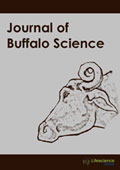jbs
Abstract : Effect of Heat Stress on Milk Production and Composition in Murrah Buffaloes
|
|
Abstract: Temperature humidity index (THI) is widely used to assess the effect of temperature and relative humidity on performance in animals. In summer the THI was between 74 – 89 with average value of 81.18. in winter months THI ranged between 49 -70 with the average of 60. The results showed a significant effect of heat stress on daily milk yield and milk composition. In the present study the daily milk yield decreases from 4.46 to 3.65kg, heat stress reduced milk yield by 18.2%. There was a significant effect of heat stress on milk composition. Heat stress significantly reduced milk fat content from 8.3% during the winter to 7.19% during the summer. Milk protein percentage significantly decreased as a result of summer heat stress (3.08 vs.2.9 %, respectively for the winter and summer). In the present study the SNF decreases from 9.08 to 9.05 %, heat stress reduced SNF % as the THI value went from ≤ 74 to ≥ 83 in summer. Results showed that milk production is a function of THI. The negative slope of regression line indicates that milk production fat%, protein% and SNF% decreases as THI increases. This regression indicates that in general for each point increase in THI value. There was decrease in milk yield of 0.028kg per buffalo per day. Heat stress environments have been associated with depression in milk fat%, protein% and SNF%. There was decrease in milk fat of 0.046% per buffalo per day. There was also decrease in milk protein of 0.00014 % per buffalo per day. The decrease in milk SNF of 0.0047 % per buffalo per day. Keywords: Temperature Humidity Index, Heat stress, Buffalo, Milk production.Download Full Article |
Abstract : Fatty Acids in the Meat of Buffaloes Supplemented with Fish Oil
|
|
Abstract: The purpose of this study has been to investigate the influence of both a supplementary fish oil diet on conjugated linoleic acid (CLA) and n6 and n3 fatty acids on intramuscular fat in Mediterranean buffalo meat. Twenty animals were randomly divided into two groups and fed with Brachiaria brizantha, 3Kg rice bran, 500 g corn and 500 g sunflower pellets for 60 days. Group I received this diet only while in group II each animal received additional 100 ml fish oil daily. Results indicated a significant decrease of palmitic fatty acid in group II (232.67 mg/g fat) in relation to group I (254.73 mg/g fat). Among unsaturated acids (AGI), the 9c 11t CLA value of group II (21.23 mg/g fat) showed an increase in relation to group I (15.80 mg/g fat), while the linoleic acid content of group II (28,85 mg/g fat) decreased significantly in relation to group I (47,00 mg/g fat). However, the alpha linolenic acid showed no significant difference between the supplemented diet group and the control group (10.31 and 10.70 mg/g fat, respectively). Group II n6/n3 ratio was narrower (2.69:1) than that of group I (4.55:1). Summing up, group II diet, which included fish oil, increased the CLA content in intramuscular fat and decreased the n6 fatty acids, improving the n6/n3 ratio. Keywords: Buffalo, meat, CLA, n 6 and n 3, fish oil.Download Full Article |






















